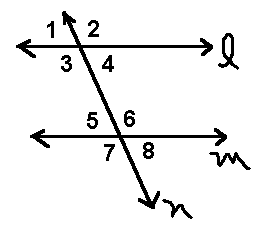what are transvaerl angles?

 1
1 
 4, angle 1 is congruent to angle 4.
4, angle 1 is congruent to angle 4. 2
2 
 3, angle 2 is congruent to angle 3.
3, angle 2 is congruent to angle 3. 5
5 
 8, angle 5 is congruent to angle 8.
8, angle 5 is congruent to angle 8. 6
6 
 7, angle 6 is congruent to angle 7.
7, angle 6 is congruent to angle 7.
what are transvaerl angles?

 1
1 
 4, angle 1 is congruent to angle 4.
4, angle 1 is congruent to angle 4. 2
2 
 3, angle 2 is congruent to angle 3.
3, angle 2 is congruent to angle 3. 5
5 
 8, angle 5 is congruent to angle 8.
8, angle 5 is congruent to angle 8. 6
6 
 7, angle 6 is congruent to angle 7.
7, angle 6 is congruent to angle 7.